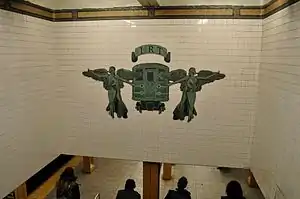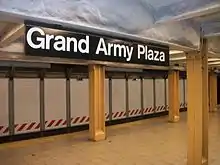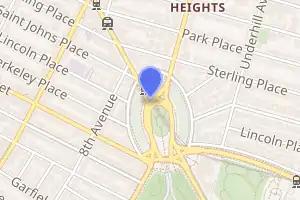Grand Army Plaza station
Grand Army Plaza is a local station on the IRT Eastern Parkway Line of the New York City Subway. It is located in Park Slope, Brooklyn, underneath Flatbush Avenue at its intersection with Plaza Street West and St. Johns Place, on the northwest side of Grand Army Plaza. It is served by the 2 train at all times, the 3 train at all times except late nights, and the 4 train during late nights.
Grand Army Plaza | ||||||||||||||||||||||||||||||||||||||||||||||||||||||||||||||||||||||||||||||||||
|---|---|---|---|---|---|---|---|---|---|---|---|---|---|---|---|---|---|---|---|---|---|---|---|---|---|---|---|---|---|---|---|---|---|---|---|---|---|---|---|---|---|---|---|---|---|---|---|---|---|---|---|---|---|---|---|---|---|---|---|---|---|---|---|---|---|---|---|---|---|---|---|---|---|---|---|---|---|---|---|---|---|---|
 Wings for the IRT: The Irresistible Romance of Travel artwork on the mezzanine level of the station | ||||||||||||||||||||||||||||||||||||||||||||||||||||||||||||||||||||||||||||||||||
| Station statistics | ||||||||||||||||||||||||||||||||||||||||||||||||||||||||||||||||||||||||||||||||||
| Address | Plaza Street West, St. Johns Place, & Flatbush Avenue Brooklyn, NY 11238 | |||||||||||||||||||||||||||||||||||||||||||||||||||||||||||||||||||||||||||||||||
| Borough | Brooklyn | |||||||||||||||||||||||||||||||||||||||||||||||||||||||||||||||||||||||||||||||||
| Locale | Park Slope | |||||||||||||||||||||||||||||||||||||||||||||||||||||||||||||||||||||||||||||||||
| Coordinates | 40.674584°N 73.970518°W | |||||||||||||||||||||||||||||||||||||||||||||||||||||||||||||||||||||||||||||||||
| Division | A (IRT) | |||||||||||||||||||||||||||||||||||||||||||||||||||||||||||||||||||||||||||||||||
| Line | IRT Eastern Parkway Line | |||||||||||||||||||||||||||||||||||||||||||||||||||||||||||||||||||||||||||||||||
| Services | 2 3 4 | |||||||||||||||||||||||||||||||||||||||||||||||||||||||||||||||||||||||||||||||||
| Transit | ||||||||||||||||||||||||||||||||||||||||||||||||||||||||||||||||||||||||||||||||||
| Structure | Underground | |||||||||||||||||||||||||||||||||||||||||||||||||||||||||||||||||||||||||||||||||
| Platforms | 1 island platform | |||||||||||||||||||||||||||||||||||||||||||||||||||||||||||||||||||||||||||||||||
| Tracks | 2 | |||||||||||||||||||||||||||||||||||||||||||||||||||||||||||||||||||||||||||||||||
| Other information | ||||||||||||||||||||||||||||||||||||||||||||||||||||||||||||||||||||||||||||||||||
| Opened | October 10, 1920 | |||||||||||||||||||||||||||||||||||||||||||||||||||||||||||||||||||||||||||||||||
| Station code | 340[1] | |||||||||||||||||||||||||||||||||||||||||||||||||||||||||||||||||||||||||||||||||
| Opposite- direction transfer | Yes | |||||||||||||||||||||||||||||||||||||||||||||||||||||||||||||||||||||||||||||||||
| Former/other names | Grand Army Plaza – Prospect Park | |||||||||||||||||||||||||||||||||||||||||||||||||||||||||||||||||||||||||||||||||
| Traffic | ||||||||||||||||||||||||||||||||||||||||||||||||||||||||||||||||||||||||||||||||||
| 2019 | 2,295,401[2] | |||||||||||||||||||||||||||||||||||||||||||||||||||||||||||||||||||||||||||||||||
| Rank | 204 out of 424[2] | |||||||||||||||||||||||||||||||||||||||||||||||||||||||||||||||||||||||||||||||||
| Station succession | ||||||||||||||||||||||||||||||||||||||||||||||||||||||||||||||||||||||||||||||||||
| Next north | Bergen Street: 2 | |||||||||||||||||||||||||||||||||||||||||||||||||||||||||||||||||||||||||||||||||
| Next south | Eastern Parkway–Brooklyn Museum: 2 | |||||||||||||||||||||||||||||||||||||||||||||||||||||||||||||||||||||||||||||||||
| ||||||||||||||||||||||||||||||||||||||||||||||||||||||||||||||||||||||||||||||||||
| ||||||||||||||||||||||||||||||||||||||||||||||||||||||||||||||||||||||||||||||||||
| ||||||||||||||||||||||||||||||||||||||||||||||||||||||||||||||||||||||||||||||||||
| ||||||||||||||||||||||||||||||||||||||||||||||||||||||||||||||||||||||||||||||||||
History
The Bergen Street, Grand Army Plaza, and Eastern Parkway–Brooklyn Museum stations opened on October 9, 1920.[3] Service on the IRT Eastern Parkway Line had been extended from Atlantic Avenue to Utica Avenue in August 1920,[4] but the three stations were not ready to open with the rest of the line.[3] This extension was part of an expansion of the subway system known as the Dual Contracts which built not only IRT lines in Brooklyn but also those for the BMT. The BMT Brighton Line was already in use at the time but used trackage that is now part of the Franklin Avenue Shuttle; the opening of the subway line beneath Flatbush Avenue provided a more direct route to Downtown Brooklyn and, eventually, Manhattan.[3][5]
The construction of the station and tunnels resulted in the removal of Frederic W. Darlington's 1897 Electric Fountain[6] from the center of Grand Army Plaza, which was dug up for the cut-and-cover construction and replaced with a grass oval. Construction began on a new fountain, known as the Bailey Fountain, in 1928, and it was completed in 1932.[7]
During the 1964–1965 fiscal year, the platforms at Grand Army Plaza, along with those at four other stations on the Eastern Parkway Line, were lengthened to 525 feet to accommodate a ten-car train of 51-foot IRT cars.[8]
Station layout
| G | Street level | Exit/entrance |
| M | Mezzanine | Fare control, station agent |
| P | Northbound local | ← ← ← |
| Island platform | ||
| Southbound local | | |
| Express/Brighton Tracks | Northbound express | ← |
| Brighton Line | ← | |
| | ||
| Southbound express | | |

At platform level, Grand Army Plaza has a simple island platform layout with two tracks.[9] Southbound (eastern Brooklyn-bound) trains use track E1 while northbound (Manhattan-bound) trains use track E4. Underneath the platform are four tracks, the center two, A4 (north) and A3 (south) carrying the BMT Brighton Line with tracks E2 and E3 carrying southbound and northbound express IRT Eastern Parkway Line trains on either side of the Brighton Line tracks, respectively.[10][11] These track designations are only displayed on small emergency placards on either end of the platform for use by train and emergency personnel; they are not used in everyday conversation.
The only mosaic in the Grand Army Plaza station is a small "P".[9] A permanent art installation in the station's entrances and mezzanine entitled Wings for the IRT: The Irresistible Romance of Travel was created in 1995 by Jane Greengold, who used the station regularly when she lived in Park Slope. The bronze and terra cotta pieces of art are modeled on the original Interborough Rapid Transit Company logo, and references the Soldiers' and Sailors' Arch in the plaza above with its Winged Victories. The MTA's Arts for Transit program held an opening ceremony for the artwork on June 19, 1997.[12][13]
Exits
The station has four entrances and exits, all of which are staircases:[14]
- 2 on the northeast corner of Flatbush Avenue and Plaza Street East
- 1 on the southwest corner of Flatbush Avenue and Plaza Street West
- 1 on the southeast corner of Flatbush Avenue and Plaza Street West
References
- "Station Developers' Information". Metropolitan Transportation Authority. Retrieved June 13, 2017.
- "Facts and Figures: Annual Subway Ridership 2014–2019". Metropolitan Transportation Authority. 2020. Retrieved May 26, 2020.
- "Subway Stations Opened: Last Three in Eastern Parkway Branch of I.R.T. Put Into Service" (PDF). New York Times. October 11, 1920. Retrieved December 20, 2015.
- "More Interborough Service for Brooklyn 2 New Lines". pudl.princeton.edu. Interborough Rapid Transit Company. August 23, 1920. Retrieved September 19, 2016.
- "IRT Brooklyn Line Opened 90 Years Ago". New York Division Bulletin. New York Division, Electric Railroaders' Association. 53 (9). September 2010. Retrieved August 31, 2016 – via Issuu.
- "Our Newest Electric Toy". Brooklyn Daily Eagle. Brooklyn, NY. August 8, 1897. p. 13.
- New York City Department of Parks and Recreation, Grand Army Plaza, accessed April 20, 2007
- Annual Report 1964–1965. New York City Transit Authority. 1965.
- Grand Army Plaza (Brooklyn IRT) NYCSubway Retrieved July 5, 2009
- Brooklyn IRT: Grand Army Plaza
- Brooklyn IRT: Map 2, Brooklyn IRT Dual Contracts
- MTA – Arts for Transit: Grand Army Plaza, accessed April 20, 2007
- MTA Headquarters Press Release, MTA Installs Art In Grand Army Plaza Station, June 19, 1997, accessed April 20, 2007
- "MTA Neighborhood Maps: Park Slope/Prospect Park" (PDF). mta.info. Metropolitan Transportation Authority. 2015. Retrieved August 2, 2015.
External links
| Wikimedia Commons has media related to Grand Army Plaza (IRT Eastern Parkway Line). |
- www.nycsubway.org:
- Brooklyn IRT: Grand Army Plaza
- Brooklyn IRT: Map 2, Brooklyn IRT Dual Contracts (includes current and former track configurations, and provisions for future connections)
- Wings for the IRT, The Irresistable [sic] Romance of Travel Artwork by Jane Greengold (1993)
- Station Reporter — 2 Train
- Station Reporter — 3 Train
- The Subway Nut — Grand Army Plaza Pictures
- MTA's Arts For Transit — Grand Army Plaza (IRT Eastern Parkway Line)
- Plaza Street entrance (northeast from Grand Army Plaza) from Google Maps Street View
- Platform from Google Maps Street View




